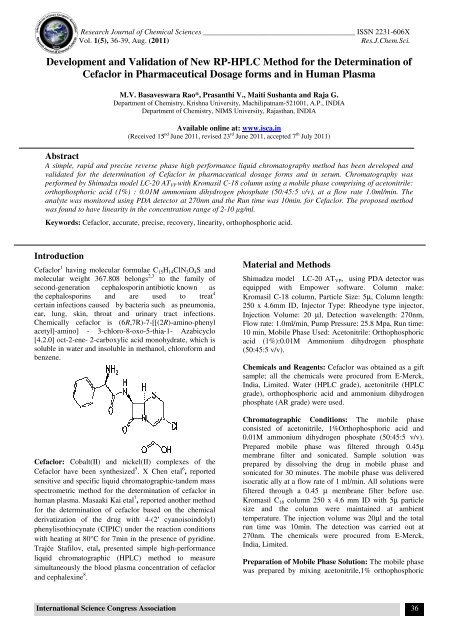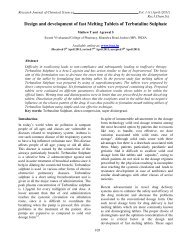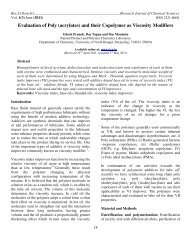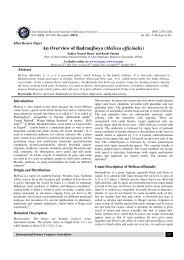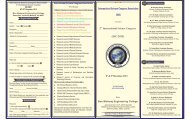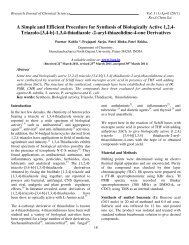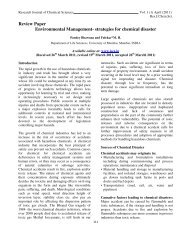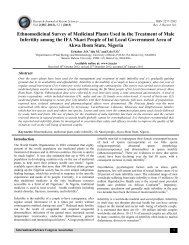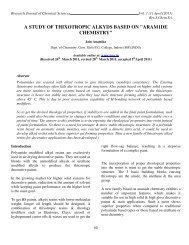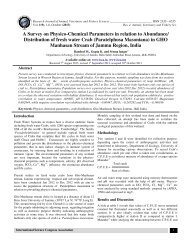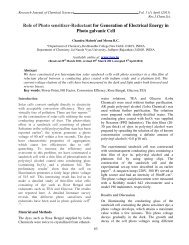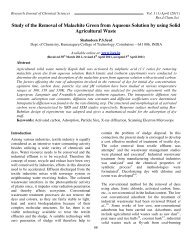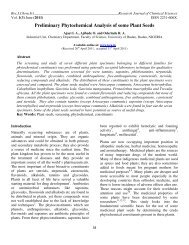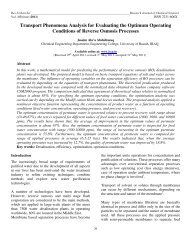Development and Validation of New RP-HPLC Method for ... - ISCA
Development and Validation of New RP-HPLC Method for ... - ISCA
Development and Validation of New RP-HPLC Method for ... - ISCA
You also want an ePaper? Increase the reach of your titles
YUMPU automatically turns print PDFs into web optimized ePapers that Google loves.
Research Journal <strong>of</strong> Chemical Sciences ________________________________________<br />
ISSN 2231-606X<br />
Vol. 1(5), 36-39, Aug. (2011)<br />
Res.J.Chem.Sci.<br />
<strong>Development</strong> <strong>and</strong> <strong>Validation</strong> <strong>of</strong> <strong>New</strong> <strong>RP</strong>-<strong>HPLC</strong> <strong>Method</strong> <strong>for</strong> the Determination <strong>of</strong><br />
Cefaclor in Pharmaceutical Dosage <strong>for</strong>ms <strong>and</strong> in Human<br />
Plasma<br />
Abstract<br />
M.V. Basaveswara Rao*, Prasanthi V., Maiti Sushanta <strong>and</strong> Raja G.<br />
Department <strong>of</strong> Chemistry, Krishna University, Machilipatnam-521001, A.P., INDIA<br />
Department <strong>of</strong> Chemistry, NIMS University, Rajasthan, INDIA<br />
Available online at: www.isca.in<br />
(Received 15 nd June 2011, revised 23 rd June 2011, accepted 7 th July 2011)<br />
A simple, rapid <strong>and</strong> precise reverse phase high per<strong>for</strong>mance liquid chromatography method has been developed <strong>and</strong><br />
validated <strong>for</strong> the determination <strong>of</strong> Cefaclor in pharmaceutical dosage <strong>for</strong>ms <strong>and</strong> in serum. Chromatography was<br />
per<strong>for</strong>med by Shimadzu model LC-20 AT VP with Kromasil C-18 column using a mobile phase comprising <strong>of</strong> acetonitrile:<br />
orthophosphoric acid (1%) : 0.01M ammonium dihydrogen phosphate (50:45:5 v/v), at a flow rate 1.0ml/min. The<br />
analyte was monitored using PDA detector at 270nm <strong>and</strong> the Run time was 10min. <strong>for</strong> Cefaclor. The proposed method<br />
was found to have linearity in the concentration range <strong>of</strong> 2-10 µg/ml.<br />
Keywords: Cefaclor, accurate, precise, recovery, linearity, orthophosphoric acid.<br />
Introduction<br />
Cefaclor 1 having molecular <strong>for</strong>mulae C 15 H 14 ClN 3 O 4 S <strong>and</strong><br />
molecular weight 367.808 belongs 2,3<br />
to the family <strong>of</strong><br />
second-generation cephalosporin antibiotic known as<br />
the cephalosporins <strong>and</strong> are used to treat 4<br />
certain infections caused by bacteria such as pneumonia,<br />
ear, lung, skin, throat <strong>and</strong> urinary tract infections.<br />
Chemically cefaclor is (6R,7R)-7-[[(2R)-amino-phenyl<br />
acetyl]-amino] - 3-chloro-8-oxo-5-thia-1-<br />
Azabicyclo<br />
[4.2.0] oct-2-ene- 2-carboxylic acid monohydrate, which is<br />
soluble in water <strong>and</strong> insoluble in methanol, chlor<strong>of</strong>orm <strong>and</strong><br />
benzene.<br />
Cefaclor: Cobalt(II) <strong>and</strong> nickel(II) complexes <strong>of</strong> the<br />
Cefaclor have been synthesized 5 . X Chen etal 6 , reported<br />
sensitive <strong>and</strong> specific liquid chromatographic-t<strong>and</strong>em mass<br />
spectrometric method <strong>for</strong> the determination <strong>of</strong> cefaclor in<br />
human plasma. Masaaki Kai etal 7 , reported another method<br />
<strong>for</strong> the determination <strong>of</strong> cefaclor based on the chemical<br />
derivatization <strong>of</strong> the drug with 4-(2′ ′ cyanoisoindolyl)<br />
phenylisothiocynate (CIPIC) under the reaction conditions<br />
with heating at 80°C <strong>for</strong> 7min in the presence <strong>of</strong> pyridine.<br />
Trajče Stafilov, etal, presented simple high-per<strong>for</strong>mance<br />
liquid chromatographic (<strong>HPLC</strong>) method to measure<br />
simultaneously the blood plasma concentration <strong>of</strong> cefaclor<br />
<strong>and</strong> cephalexine 8 .<br />
Material <strong>and</strong> <strong>Method</strong>s<br />
Shimadzu model LC-20 AT VP , using PDA detector was<br />
equipped with Empower s<strong>of</strong>tware. Column make:<br />
Kromasil C-18 column, Particle Size: 5µ, Column length:<br />
250 x 4.6mm ID, Injector Type: Rheodyne type injector,<br />
Injection Volume: 20 µl, Detection wavelength: 270nm,<br />
Flow rate: 1.0ml/min, Pump Pressure: 25.8 Mpa, Run time:<br />
10 min, Mobile Phase Used: Acetonitrile: Orthophosphoric<br />
acid (1%):0.01M Ammonium dihydrogen phosphate<br />
(50:45:5 v/v).<br />
Chemicals <strong>and</strong> Reagents:<br />
Cefaclor was obtained as a gift<br />
sample; all the chemicals were procured from E-Merck,<br />
India, Limited. Water (<strong>HPLC</strong> grade), acetonitrile (<strong>HPLC</strong><br />
grade), orthophosphoric acid <strong>and</strong> ammonium dihydrogen<br />
phosphate (AR grade) were used.<br />
Chromatographic Conditions:<br />
The mobile phase<br />
consisted <strong>of</strong> acetonitrile, 1%Orthophosphoric acid <strong>and</strong><br />
0.01M ammonium dihydrogen phosphate (50:45:5 v/v).<br />
Prepared mobile phase was filtered through 0.45µ<br />
membrane filter <strong>and</strong> sonicated. Sample solution was<br />
prepared by dissolving the drug in mobile phase <strong>and</strong><br />
sonicated <strong>for</strong> 30 minutes. The mobile phase was delivered<br />
isocratic ally at a flow rate <strong>of</strong> 1 ml/min. All solutions were<br />
filtered through a 0.45 µ membrane filter be<strong>for</strong>e use.<br />
Kromasil C 18 column 250 x 4.6 mm ID with 5µ particle<br />
size <strong>and</strong> the column were maintained at ambient<br />
temperature. The injection volume was 20µl <strong>and</strong> the total<br />
run time was 10min. The detection was carried out at<br />
270nm. The chemicals were procured from E-Merck,<br />
India, Limited.<br />
Preparation <strong>of</strong> Mobile Phase<br />
Solution: The mobile phase<br />
was prepared by mixing acetonitrile,1% orthophosphoric<br />
International Science Congress Association<br />
36
Research Journal <strong>of</strong> Chemical Sciences _______________________________________________________ ISSN 2231-606X<br />
Vol. 1(5), 36-39, Aug. (2011)<br />
Res.J.Chem.Sci.<br />
acid <strong>and</strong> 0.01M ammonium dihydrogen phosphate (50:45:5<br />
v/v) by ultra bath sonicated <strong>for</strong> 30 min.<br />
Preparation <strong>of</strong> St<strong>and</strong>ard: Stock solution <strong>of</strong> Cefaclor was<br />
prepared by dissolving accurately weighed 10mg <strong>of</strong> drugs<br />
in 10ml methanol (final concentration, 1000µg/ml). The<br />
prepared stock solutions were stored away from light.<br />
From the stock, st<strong>and</strong>ard solutions was freshly prepared<br />
during the day <strong>of</strong> analysis.<br />
Preparation <strong>of</strong> Working St<strong>and</strong>ard Solution (a.p.i):<br />
From the stock solution 1mmg/ml solution was prepared.<br />
Preparation <strong>of</strong> Working St<strong>and</strong>ards <strong>for</strong> Linearity:<br />
Solutions in the concentration range <strong>of</strong> 0.1-0.5mg/ml were<br />
prepared from the st<strong>and</strong>ard working solution.<br />
Linearity <strong>and</strong> Calibration: Linearity was assessed by<br />
per<strong>for</strong>ming single measurement at several analyte<br />
concentration varying quantities <strong>of</strong> stock st<strong>and</strong>ard solution<br />
diluted with the mobile phase to give a concentration <strong>of</strong><br />
0.1, 0.2, 0.3, 0.4 <strong>and</strong> 0.5 mg/ml. Injection was made at<br />
intervals <strong>of</strong> 6min. The linearity was tested <strong>for</strong> the<br />
concentration ranging from 0.1-0.5mg/ml. The peak area<br />
ratio <strong>of</strong> the drug was plotted against concentration. The<br />
linearity was evaluated by linear regression analysis, which<br />
was calculated by the least square regression method.<br />
Precision: Reproducibility was per<strong>for</strong>med by injecting<br />
three replicates concentrations <strong>of</strong> st<strong>and</strong>ard <strong>and</strong> sample<br />
solutions which were prepared <strong>and</strong> analyzed by same<br />
analyst on same day. Inter-day variations in the peak area<br />
<strong>of</strong> drug solutions <strong>and</strong> the amount <strong>of</strong> drug were calculated<br />
in terms <strong>of</strong> Percentage Relative St<strong>and</strong>ard Deviation.<br />
Sample concentration is 1mg/1ml.<br />
Accuracy: Recovery assessment was obtained by using<br />
st<strong>and</strong>ard addition technique which was by adding known<br />
quantities <strong>of</strong> pure st<strong>and</strong>ards at three different levels in<br />
80%, 100% <strong>and</strong> 120% to the pre analyzed sample<br />
<strong>for</strong>mulation.<br />
Assay: The estimation <strong>of</strong> drug in pharmaceutical dosage<br />
<strong>for</strong>ms. Cefalor tablets <strong>of</strong> 0.1mg strength were evaluated <strong>for</strong><br />
the amount <strong>of</strong> Cefaclor present in the <strong>for</strong>mulation. Each<br />
sample was analyzed in triplicate after extracting the drug.<br />
The amount <strong>of</strong> drug present in <strong>for</strong>mulation was calculated<br />
by comparing the mean peak area from st<strong>and</strong>ard.<br />
Intermediate Precision or Ruggedness: Inter-day<br />
variations were per<strong>for</strong>med by using six replicate injections<br />
<strong>of</strong> st<strong>and</strong>ard <strong>and</strong> sample solutions <strong>of</strong> concentrations which<br />
were prepared <strong>and</strong> analyzed by different analyst on three<br />
different days over a period <strong>of</strong> one week. Ruggedness also<br />
expressed in terms <strong>of</strong> percentage relative st<strong>and</strong>ard<br />
deviation.<br />
Robustness: Robustness was carried out by varying two<br />
parameters from the optimized chromatographic<br />
conditions.<br />
Specificity: The method was determined as specific by<br />
comparing test results obtained from analyses <strong>of</strong> sample<br />
solution containing excuse ingredients with that <strong>of</strong> test<br />
results those obtained from st<strong>and</strong>ard drug.<br />
System Suitability Parameter: System suitability tests<br />
were carried out on freshly prepared st<strong>and</strong>ard stock<br />
solutions <strong>of</strong> Cefaclor <strong>and</strong> it was calculated by determining<br />
the st<strong>and</strong>ard deviation <strong>of</strong> Cefaclor st<strong>and</strong>ards by injecting<br />
st<strong>and</strong>ards in five replicates at 10 minutes interval <strong>and</strong> the<br />
values were recorded.<br />
Preparation <strong>of</strong> Formulation Sample Solution: 20mg<br />
Ceflor Dps powder (50mg <strong>for</strong>mulation) was weighed <strong>and</strong><br />
dissolved in 10ml mobile phase. The resultant sample<br />
solution concentration is 2mg/ml then sonicated by ultra<br />
bath sonicated <strong>for</strong> 30 minutes <strong>and</strong> filtered through 0.45µm<br />
membrane filter. The amount <strong>of</strong> drug present in the 100mg<br />
<strong>for</strong>mulation was calculated from linearity graph.<br />
Preparation <strong>of</strong> Serum Sample Solution: 0.5ml <strong>of</strong> this<br />
serum was taken in a test tube <strong>and</strong> added 100µl <strong>of</strong> diltizem<br />
hydrochloride (1µg/ml) <strong>and</strong> 0.1ml <strong>of</strong> 1M NaOH <strong>and</strong> 5ml <strong>of</strong><br />
dichloromethane <strong>and</strong> mixed about 20min in vortex mixer<br />
<strong>and</strong> centrifuged at 3000 rpm <strong>for</strong> 10min. From this<br />
centrifuged solution 4ml <strong>of</strong> organic layer was separated<br />
<strong>and</strong> evaporated to dryness to get residue. To this residue<br />
100µl <strong>of</strong> 1M acetic acid <strong>and</strong> 3ml <strong>of</strong> n-hexane <strong>and</strong> mixed<br />
<strong>for</strong> 5 min by vortex mixer <strong>and</strong> evaporated the organic layer<br />
<strong>and</strong> finally the remaining sample was injected into <strong>HPLC</strong><br />
<strong>and</strong> chromatogram was recorded. The amount <strong>of</strong> drug<br />
present in the blood sample was calculated from linearity<br />
graph.<br />
Results <strong>and</strong> Discussion<br />
The Reverse Phase high per<strong>for</strong>mance liquid<br />
Chromatography method was developed by a stability<br />
indicating assay method. Pure drugs chromatogram was<br />
run in different mobile phases containing methanol,<br />
acetonitrile, THF, <strong>and</strong> different buffers like potassium<br />
dihydrogen phosphate, sodium dihydrogen phosphate,<br />
Ortho phosphoric acid in different volumes ratios.<br />
Different columns like C 8 , C 18 , phenyl, cyano with<br />
different dimensions were used. Then retention time <strong>and</strong><br />
tailing factor were calculated. Finally acetonitrile <strong>and</strong> 1%<br />
orthophosphoric acid <strong>and</strong> 0.01M ammonium dihydrogen<br />
phosphate in the ratio <strong>of</strong> 50:45:5 v/v (P H :3.4) <strong>and</strong> Kromasil<br />
C 18 analytical column was selected which gave a sharp <strong>and</strong><br />
symmetrical peak with 1.82 tailing. Calibration graph was<br />
found to be linear at range 0.1mg/ml to 0.5mg/ml. Five<br />
different concentrations <strong>of</strong> Cefaclor in range given above<br />
were prepared <strong>and</strong> 20µl <strong>of</strong> each concentration injected in<br />
<strong>HPLC</strong> as shown in the table 1, figure 1. The slope (m) <strong>and</strong><br />
intercept (c) obtained were found to be 170955.95 <strong>and</strong> -<br />
0.03.The correlation <strong>of</strong> coefficient (r 2 ) obtained was found<br />
to be 0.9626 as shown in the table 1. It was observed that<br />
the concentration range showed a good relationship. The<br />
limit <strong>of</strong> detection <strong>for</strong> Cefaclor was found to be 40µg/ml<br />
<strong>and</strong> the limit <strong>of</strong> quantification was found to be 75µg/ml. It<br />
International Science Congress Association 37
Research Journal <strong>of</strong> Chemical Sciences _____________________________________________________<br />
ISSN 2231-606X<br />
Vol. 1(5), 36-39, Aug. (2011)<br />
Res.J.Chem.Sci.<br />
proves the sensitivity <strong>of</strong> method. The Percentage assay <strong>of</strong><br />
Cefaclor in <strong>for</strong>mulation was found to be 67.02%. as shown<br />
in the table 1 <strong>and</strong> figure 3. The relative st<strong>and</strong>ard deviation<br />
value obtained was below 1 which indicates the precession<br />
<strong>of</strong> the method. The validation <strong>of</strong> the proposed method was<br />
further verified by recovery studies. The data was<br />
presented by in the table 2 <strong>and</strong> figure 2. The percentage<br />
recovery was found to be 104.35% which shows a good<br />
index <strong>of</strong> accuracy <strong>of</strong> the developed method. The amount <strong>of</strong><br />
drug present in the human serum sample was calculated<br />
from the linearity graph was found to be 1.079 mg/ 0.5ml<br />
as shown in table 3 <strong>and</strong> figure 4.<br />
Table -1<br />
Optical Chracterisation <strong>of</strong> Cefaclor<br />
Parameters<br />
Linearity range(mg/ml)<br />
Correlation coefficient(r)<br />
Slope(m) 170955.95<br />
Intercept(c)<br />
Limit <strong>of</strong> detection (LOD; µg/ml)<br />
Limit <strong>of</strong> Quantification (LOQ;<br />
µg/ml)<br />
Tailing factor<br />
Retention time (min)<br />
Theoretical plates<br />
( % ) R.S.D<br />
( % )Accuracy<br />
( % )Formulation<br />
Serum (mg/0.5ml)<br />
Pharmaceutical<br />
<strong>for</strong>mulation<br />
(br<strong>and</strong> name)<br />
Table-2<br />
Recovery Data <strong>of</strong> Cefaclor<br />
Labeled<br />
amount<br />
(mg)<br />
Percentag<br />
e<br />
Assay<br />
KEFLOR 50 mg 67.02<br />
*Average value <strong>of</strong> three different levels in triplicate<br />
Conclusion<br />
Cefaclor<br />
0.1 – 0.5<br />
0.9626<br />
-0.03<br />
The <strong>RP</strong>-high per<strong>for</strong>mance liquid chromatographic method<br />
<strong>for</strong> the analysis <strong>of</strong> Cefaclor from their <strong>for</strong>mulations was<br />
found to be accurate <strong>and</strong> precise. Thus, the proposed<br />
<strong>HPLC</strong> method can be successfully applied <strong>for</strong> the routine<br />
quality control analysis <strong>of</strong> Cefaclor <strong>for</strong>mulations. This<br />
method could be a simple <strong>for</strong> the practical applications <strong>and</strong><br />
comparatively better method than the reported ones in the<br />
literature.<br />
40<br />
75<br />
1.82<br />
6.053<br />
3927.42<br />
0.148<br />
104.35<br />
67.02<br />
1.079<br />
Percenta<br />
ge<br />
recovery<br />
104.35<br />
Figure-1<br />
Chromatogram <strong>of</strong> cefaclor (st<strong>and</strong>ard)<br />
Figure-2<br />
Chromatogram <strong>of</strong> Cefaclor (Accuracy)<br />
Figure-3<br />
Chromatogram <strong>of</strong> cefaclor<br />
(<strong>for</strong>mulation assay)<br />
International Science Congress Association<br />
38
Research Journal <strong>of</strong> Chemical Sciences _____________________________________________________<br />
ISSN 2231-606X<br />
Vol. 1(5), 36-39, Aug. (2011)<br />
Res.J.Chem.Sci.<br />
4. King B.A, Geelhoed G.C, Adverse skin <strong>and</strong> joint<br />
reactions associated with oral antibiotics in children:<br />
the role <strong>of</strong> cefaclor in serum sickness-like reactions. J<br />
Paediatr., Child Health., 39 (9), 677–81 (2003)<br />
5. Chohan Z.H. Chem. Pharm. Bull., (Tokyo)., 1578-<br />
80 (1991)<br />
6. Chen X., Zhong D., Huang B., Cui J.,<br />
Determination <strong>of</strong> cefaclor in human plasma by a<br />
sensitive <strong>and</strong> specific liquid chromatography, J<br />
Chromatogr., B Analyt., Technol Biomed Life Sci.,<br />
784, 17-24 (2003)<br />
References<br />
Figure-4<br />
Chromatogram <strong>of</strong> cefaclor (serum)<br />
1. The Merck Index, 13 th edition, Merck <strong>and</strong> company,<br />
INC, White House station, NJ, 324 (2001)<br />
2. Hebert A, Sigman E, Levy M., Serum sickness-like<br />
reactions from cefaclor in children J. Am. Acad.<br />
Dermatol., 25, 805-8 (1991).<br />
3. Parra F., Igea J., Martín J., Alonso M., Lezaun A.,<br />
Sainz T., Serum sickness-like syndrome associated<br />
with cefaclor therapy, Allergy., 47, 439–40 (1992)<br />
7. Masaaki K., Hiromi Kinoshita Kazuko O., Shuuji H.,<br />
Myung K.L <strong>and</strong> Jianzhong L., Sensitive<br />
determination <strong>of</strong> a β-lactam antibiotic, cefaclor by<br />
liquid chromatography with chemiluminescence<br />
detection. Journal <strong>of</strong> Pharmaceutical <strong>and</strong> Biomedical<br />
Analysis, 30(6), 1765-1771 (2003)<br />
8. Trajče S <strong>and</strong> Dragica Z., Determination <strong>of</strong> Cefaclor<br />
<strong>and</strong> cephalexine in blood Plasma by <strong>HPLC</strong>, Adnan<br />
Menderes University, 4 th AACD Congress, Kuşadası-<br />
AYDIN/ TURKEY Proceedings Book 082., DOC.,<br />
2004<br />
International Science Congress Association<br />
39


